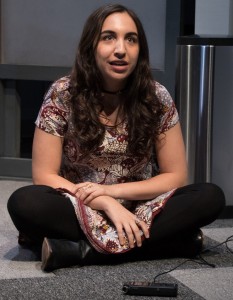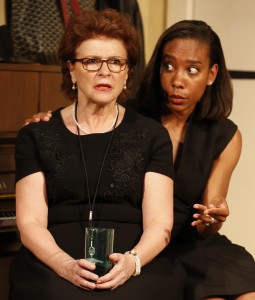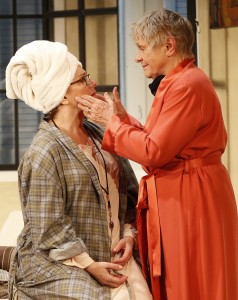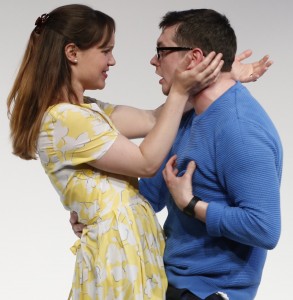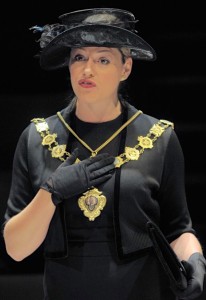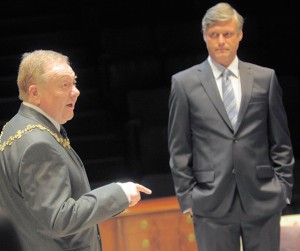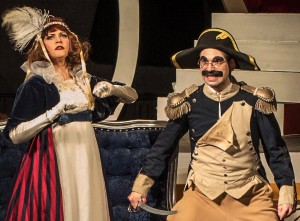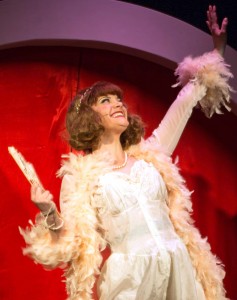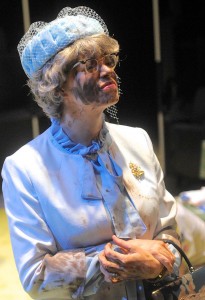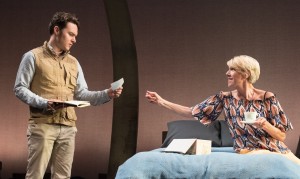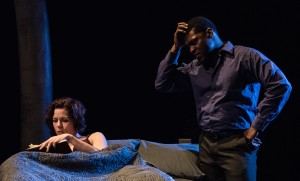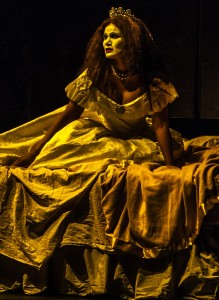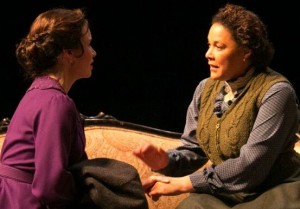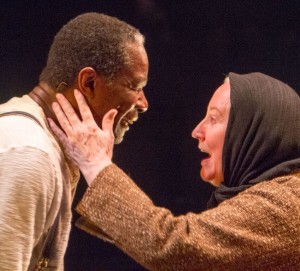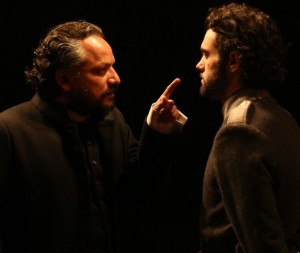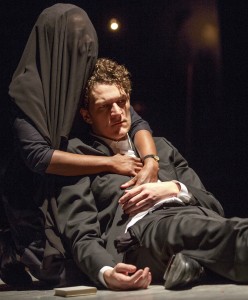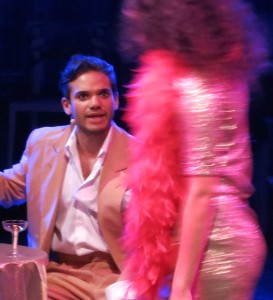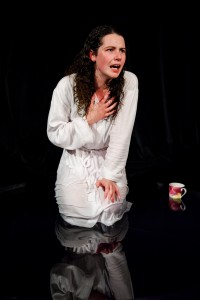Comedy is a tricky commodity. Many a writer, comedian, and movie has gone down in flames, and it would be too simple to say that it’s all in the writing. Yet, even the best comedic writing in the wrong hands can feel flat and lifeless. Satirical, musical comedy is even more challenging. Some of the best theater has been created by a team, adept at pulling and pushing each other to new heights. Here I Sit, Broken Hearted ... A Bathroom Odyssey is written, directed, and stars Seth Panitch with original music by R. Johnson Hall. It chronicles the world of bathroom graffiti and also stars Ian Anderson, Matt Lewis, and Chip Persons.
The set design, by Mike Morin, is a men’s bathroom with four stalls scribbled with graffiti. The back wall above the stalls is used for projection of corresponding graffiti and photos; given the set design, it is difficult to read the visuals displayed and it quickly becomes annoying. The speakers for the music are keenly hidden in the trash receptacles on either side of the stage.
Coughing and shuffling can be heard behind the stall doors and they open to reveal the actors sitting on the commodes. Spoofing “Taking a Chance on Love,” they begin to sing.
Here I go again,
I hear those trumpets blow again.
Me on my throne again...
Taking a chance on love!
Sadly, the comedy of Here I Sit, Broken Hearted never rises above these lyrics; it misses the mark on practically every level. The saving grace, beyond the short 60-minute length, is the pure joie de vivre of the cast, specifically Anderson and Lewis. If the actors suspect that the material isn’t funny, current, or satirical, they never let on. Purely for trying to make it work they deserve kudos. A cameo appearance by an unnamed young woman is quite cute. Thinking she’s entered the women’s room, she walks in to find four white guys rapping. Incredulous, she asks “Were you guys ... you didn’t happen to be—rapping, did you?”
The fault in this piece lays squarely on Panitch. When one is so heavily entrenched in the creative process, it can be difficult to step far enough away from the material to discern what’s really good and what should be dumped. The monkey mind keeps insisting, ‘This is really good.’ This time the monkey lied.
With "South Park" and The Book of Mormon, not to mention countless movies, bathroom humor, full of innuendo and fart jokes, has been done, and Here I Sit, Broken Hearted feels dated. It takes a deft hand and slightly twisted mind to write new bathroom material. The song choices sound as if they are meant for an older audience, as well as the lyrics. Imagine the Catskills circa 1970. Second, it’s unusual to find a public bathroom like this any longer except at the beach or maybe a highway rest stop, so the references are difficult to pull off in 2016 Manhattan. A giant blow-up condom bit, immediately followed by a scene with two giant blow-up penises, is not even sophomoric enough to relish a laugh.
Given the sexual exploits of politicians and bathrooms, Panitch misses opportunity after opportunity, instead choosing to dress two of the actors to look like Donald Trump and Hillary Clinton who have little, if anything, to do with a public restroom. Gilded, maybe, but a public restroom, hardly. Public restrooms are notorious for sex, yet there is little that is sexy about Here I Sit, Broken Hearted.
While the four actors get on and off the toilets they continually wear some form of underwear. There are countless ways to be coy and funny while teasing some nudity, a la the full monty, with sleight of hand or lighting, and it would seem appropriate for a bathroom musical. Instead, they continue to pull up underwear on top of underwear, stopping short of what could have been quite fun.
The icing on this pile is when Panitch recounts a visit to the Western Wall in Jerusalem when he turned 13, seeing prayers stuffed into the crevices between the ancient stones. “So, when I entered that fateful bathroom stall that day, and saw once again that famous refrain on the wall, I was strangely reminded of the Western Wall.” Attempting to correlate one of the most sacred sites on the planet, holding the prayers of the faithful, to bathroom graffiti is beyond a stretch of the imagination and borders on the profane.
Here I Sit, Broken Hearted… A Bathroom Odyssey runs until July 9 at the Beckett Theatre at Theatre Row (410 W. 42nd St. at Ninth Avenue). Performances are Wednesday through Saturday at 8 p.m. and Sunday at 3 p.m. Tickets are $19.25. To purchase them, call 212-239-6200 or visit Telecharge.com.
à la









